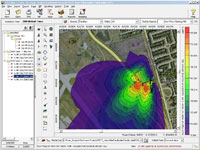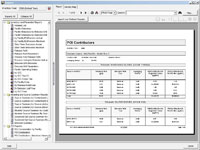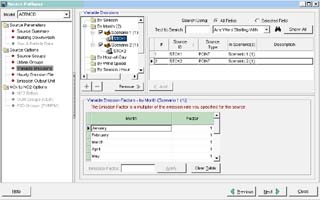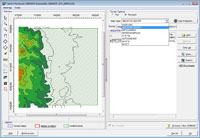Lakes Environmental e-Newsletter
News & Events
AERMOD View™ Version 6.2.1 Released!
Lakes Environmental is pleased to announce the release of AERMOD View Version 6.2.1. This latest release of AERMOD View adds several new features including:
- RiskGen for AERMOD – The risk assessment air dispersion modeling input file generator is now available for use with AERMOD.
- Canadian Digital Elevation Data (CDED) – The Terrain Processor now has an automated download option for Canadian 1-degree and 15-minute DEM data.
Please see our AERMOD View Version 6.2.1 Release Notes for a complete list of these new features.
If you are currently in maintenance for AERMOD View and did not receive an email regarding this update, please contact us at support@weblakes.com.
If you are a user of AERMOD View but are no longer in maintenance, contact us at sales@weblakes.com to find out how you can start using version 6.2.1 today!
Recent US EPA Memoranda
The US EPA has recently released several memoranda concerning the use of CALPUFF and AERMOD models. These memoranda are listed below and can also be viewed on the US EPA SCRAM website.
Memorandum 1: Clarification on the EPA-FLM Recommended Settings for CALMET
AUGUST 31, 2009 - This memorandum updates the draft recommendations for CALMET settings. In particular it addresses issues with the previous recommendations for CALMET settings with the use of prognostic meteorological data, which may have had a negative impact on the model performance. A full table of recommended CALMET settings is provided.
Read Memorandum
Memorandum 2: Use of Non-Default Radius for Determining Surface Roughness Length for AERMET
SEPTEMBER 17, 2009 - This memorandum discusses a request for the use of a non-default radius for determining surface roughness length for AERMET modeling. The request is based on a change in surface roughness just beyond the default 1km radius, and the merits of this request are discussed.
Read Memorandum
Memorandum 3: CALPUFF Modeling Protocol for BART
MAY 27, 2009 - A clarification on the use of the BART protocol is provided to Region 8 for a specific case. Additionally, revisions to the IWAQM Phase 2 recommendations are suggested.
Read Memorandum
Memorandum 4: Reassessment of IWAQM Phase 2 Recommendations
MAY 27, 2009 - In support of the above memo, this report provides a draft reassessment of the IWAQM phase 2 recommendations.
Read Memorandum
Product Spotlight - FETS View™
Facility Emissions Tracking System
 FETS View is a powerful customizable software solution that integrates a facility-wide emissions inventory tracking system with air dispersion modeling. FETS View allows a facility to manage a large number of emission sources and pollutants in one, easy-to-use interface.
FETS View is a powerful customizable software solution that integrates a facility-wide emissions inventory tracking system with air dispersion modeling. FETS View allows a facility to manage a large number of emission sources and pollutants in one, easy-to-use interface.
The emission and source data stored in the system is used to perform AERMOD or CALPUFF air dispersion modeling to demonstrate compliance with environmental regulations. This solution allows you to model for different types of emissions and averaging times, screen out negligible sources, and choose from many other modeling and formatting options. Once your modeling is complete, FETS View’s detailed integrated GIS and graphics make it easy to view modeling results for your site, analyze impacts and present results to key stakeholders.
FETS View’s Key Features:
- Highly organized structured hierarchy for entering and managing large volumes of site data
- Integration of the emissions inventory and air dispersion modeling components eliminating the need to import and export model files with external applications
- Ability to maintain unlimited model scenarios and inventory cases
- Robust batch mode processing option
- Integrated U.S. EPA TANKS modeling
- Integrated U.S. EPA emission calculators including AP-42, EIIP, and NEI
 In addition, a wide variety of pre-defined reports assists you in documenting your compliance with local air pollution regulations. Your results are presented professionally using FETS View’s highly customizable contour plotting capability for visualization of the pollutant impacts. Reports and plots can be effortlessly exported into several commonly used formats.
In addition, a wide variety of pre-defined reports assists you in documenting your compliance with local air pollution regulations. Your results are presented professionally using FETS View’s highly customizable contour plotting capability for visualization of the pollutant impacts. Reports and plots can be effortlessly exported into several commonly used formats.
For more information or to schedule a web demonstration for you and your colleagues please contact sales@weblakes.com.
We look forward to hearing from you!
A&WMA Conference - Guideline on Air Quality Models: Next Generation of Models
On October 28-30, modelers will head to Raleigh, North Carolina for A&WMA's Conference: Guideline on Air Quality Models: Next Generation of Models.
This conference will provide a unique opportunity to consultants, regulatory agencies, and industry to take part in a technical forum to discuss proposed revisions to the US EPA’s Guideline on Air Quality Models.
Lakes Environmental is a proud sponsor of this event!
Don’t miss out! Register today by visiting A&WMA’s event website.
We look forward to meeting you there!
Lakes Environmental Closed For Thanksgiving Day
Lakes Environmental will be closed on Monday, October 12th to observe the Canadian Thanksgiving holiday. If you have any pressing needs during that time, please e-mail us at support@weblakes.com and we will contact you on October 13th when our offices reopen.
Lakes Environmental Is On The Move!
Lakes Environmental is happy to announce that we are moving to a new location. As of November 1, 2009 we will be located at a new facility in order to serve your needs even better.
For your convenience the address for our new office is listed below. Please ensure that you update your records to reflect this change. Our phone and fax numbers will remain the same.
Lakes Environmental Software
60 Bathurst Drive, Unit 3
Waterloo, Ontario, N2V 2A9 CANADA
Phone: +1.519.746.5995 | Fax: +1.519.746.0793
Thank you for your patience and cooperation during this time of transition. We look forward to hearing from you at our new facility!
Upcoming Courses
Date |
Course |
Location |
Registration |
Oct 19-20, 2009 |
|||
Nov 09-10, 2009 |
|||
Nov 16-17, 2009 |
For more information on the above courses, including registration information, location, and course outlines, please visit our web site: https://www.weblakes.com/courses.html.
Modeling Tip
Varying Exit Temperatures of Point Sources in AERMOD
In order to regulate your stacks' temperatures throughout the year, it is recommended that you use "hourly emission files" in AERMOD View.
There may be times that you are presented with a simplified case. In this instance, the following work around would be applicable. This will avoid the labor intensive process of creating an hourly emission file.
Problem:
Variable emissions will let you change emission factors but will not permit the user to define different operating temperatures.
Solution:
- Create 2 identical stacks at the same location (e.g., STACK-1A and STACK-1B)
- For STACK-1A specify the first operating temperature A
- For STACK-1B specify the second operating temperature B
- Go to the Variable Emissions dialog in the Source Pathway
- Choose the applicable emission period (season, month etc.)
Step 1 - Create an emission scenario for STACK-1A:
- Enter an emission factor of 1 (100%) for the time period which the first operating temperature (A) applies. Enter 0 (0%) for the remainder of the time.
Step 2 - Create an emission scenario for STACK-1B:
- Enter an emission factor of 1 (100%) for the time period which the second operating temperature (B) applies. Enter 0 (0%) for the remainder of the time.

Note: Please note this is a work around. It is always best to use an Hourly Emission file in case stack parameters, such as temperature, are variable.
Remember: We are accepting submissions for the Monthly Modeling Tip that appears in our newsletters. See below information on how to submit your helpful tip today!
Submit Your Modeling Tip Today!
We are currently accepting submissions for the Monthly Modeling Tip that appears in our newsletters. If you have a modeling tip that may benefit a variety of people, please send it to us at support@weblakes.com. Your name and the name of your organization will appear below the tip providing you with greater exposure.
Articles
New Carbon Dioxide Data Helps Unlock the Secrets of Antarctic Formation
ScienceDaily (Sep. 14, 2009) — The link between declining CO2 levels in the earth's atmosphere and the formation of the Antarctic ice caps some 34 million years ago has been confirmed for the first time in a major research study.
A team of scientists from Cardiff, Bristol and Texas A&M universities braved the lions and hyenas of a small East African village to extract microfossils in samples of rocks which show the level of CO2 in the Earth's atmosphere at the time of the formation of the ice-cap.
Read Article
Another Factor that Impacts our Climate
September 13, 2009 - Just when we were getting confident that we understood the most important factors affecting the earth’s weather and climate, new research creates some surprises. UCLA atmospheric scientists have discovered a previously unknown basic mode of energy transfer from the solar wind to the Earth's magnetosphere. The research, federally funded by the National Science Foundation, could improve the safety and reliability of spacecraft that operate in the upper atmosphere. It could also help us understand the weather and previously unknown affects on our climate.
Read Article
EPA to Review 79 Coal Mine Permits
September 11, 2009 - CHARLESTON, W.Va. - The Obama administration on Friday stepped up its efforts to curb environmental damage from surface coal mining, announcing plans to give 79 permit applications in four states additional scrutiny.
The Environmental Protection Agency said it wants to make certain the proposed mines won’t cause water pollution and violate the Clean Water Act. An initial review concluded all 79 probably would affect water quality and require additional study, the EPA said.
Forty-nine of the permits are for mines in Kentucky, the nation’s No. 3 coal-producing state. The list also includes 23 mines in West Virginia, the nation’s No. 2 producer behind Wyoming, six in Ohio and one in Tennessee.
Read Article
India Could Halve Emissions Growth, at a Cost
September 10, 2009 – Growth in India's carbon emissions could be nearly halved by the year 2030 through the use of known practices and technologies, according to a new report from McKinsey & Company.
Through a "step-change in...efforts to lower emissions," India's carbon output could grow from 1.6 billion tons in 2005 to only 2.8 billion tons in 2030 as the country's population expands and its economy develops, the report said. This is down from a previously projected 5-6 billion tons for 2030.
Read Article
Global Cleantech 100 Unveils Most Promising Clean Technology Companies on the Planet
September 9, 2009 – The Guardian and Cleantech Group(TM), LLC, providers of leading research, events and advisory services for the cleantech ecosystem, have announced the Global Cleantech 100 - the first ever list of this scale highlighting the most promising private clean technology companies around the world. Supported by the Carbon Trust, the Global Cleantech 100 recognises companies at the forefront of cleantech innovation offering solutions to some of the world’s most pressing environmental challenges.
The final list represents the collective opinion of hundreds of leading experts from cleantech innovation and venture capital companies in EMEA, North America, India and China, combined with the specific input of an expert panel of 35, drawn from well-respected organisations such as Altira Group, Crossover Advisors, Deloitte, Emerald Technology Ventures, Google, Kleiner Perkins Caulfield & Byers, New York Stock Exchange, NGEN Partners, Nth Power, New Enterprise Associates, Sterling Communications, Tsing Capital and VantagePoint Venture Partners.
Read Article
Upcoming Conferences & Trade Shows
Date |
Conference |
Location |
Sep 22-24, 2009 |
Carbon Capture and Storage World Summit |
Arlington, Virginia, USA |
Sep 23-25, 2009 |
9th International Conference and Exhibition on Emissions Monitoring (CEM 2009) |
Milan, Italy |
Oct 26-27, 2009 |
Carbon Forum Asia 2009 |
Singapore |
Oct 26-29, 2009 |
Air Quality VII Conference |
Arlington, Virginia, USA |
Oct 28-30, 2009 |
A&WMA's Conference - Guideline on Air Quality Models: Next Generation of Models* |
Raleigh, North Carolina, USA |
Nov 16-19, 2009 |
11th International Symposium on Environmental Issues and Waste Management in Energy and Mineral Production (SWEMP 2009) |
Banff, Alberta, Canada |
Nov 19-23, 2009 |
SETAC 30th Annual Meeting |
New Orleans, Lousiana, USA |
Dec 1-4, 2009 |
Pollutec Horizons* |
Paris, France |
* Lakes Environmental is attending both A&WMA's Conference & Pollutec Horizons
About this Newsletter
This newsletter contains information gleaned from various sources on the web, with complete links to the sources cited. Organizations cited are in no way affiliated with Lakes Environmental Software.
Lakes Environmental Software is a leading environmental IT company that offers a complete line of air dispersion modeling, risk assessment, emissions inventory, and emergency release software as well as training and custom software services. With satisfied users located around the globe, Lakes Environmental Software will continue to revolutionize the environmental software field.
For more information please visit our web site at: www.weblakes.com. You may also contact us by phone at (519) 746-5995 or by fax at (519) 746-0793.
All comments and suggestions are welcome. You can e-mail us at: support@weblakes.com.
Please click the link below to subscribe or unsubscribe from this newsletter:
Subscribe/Unsubscribe







